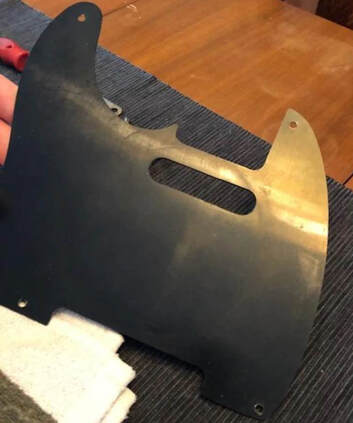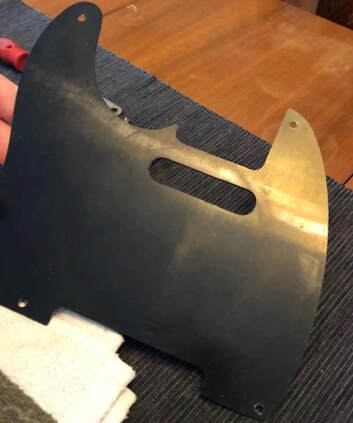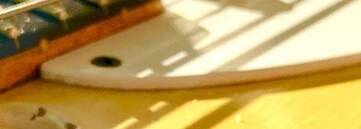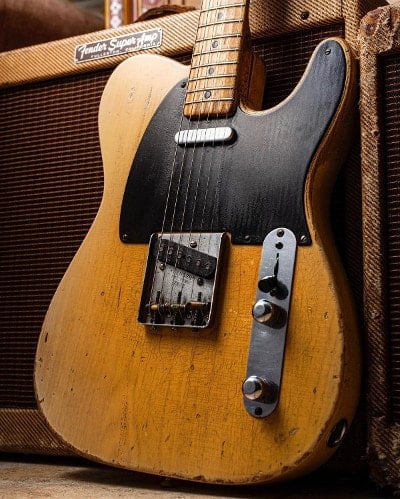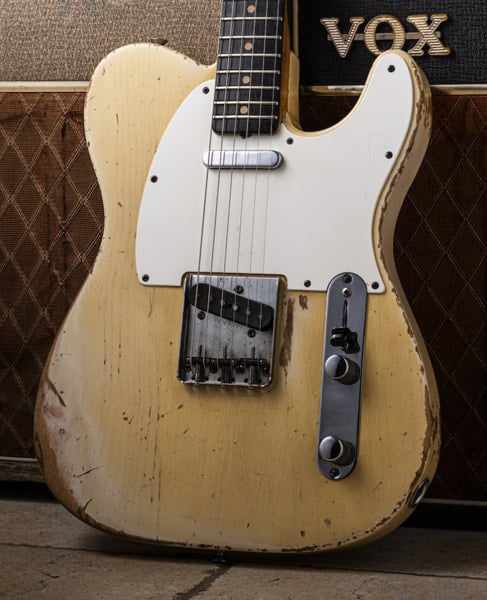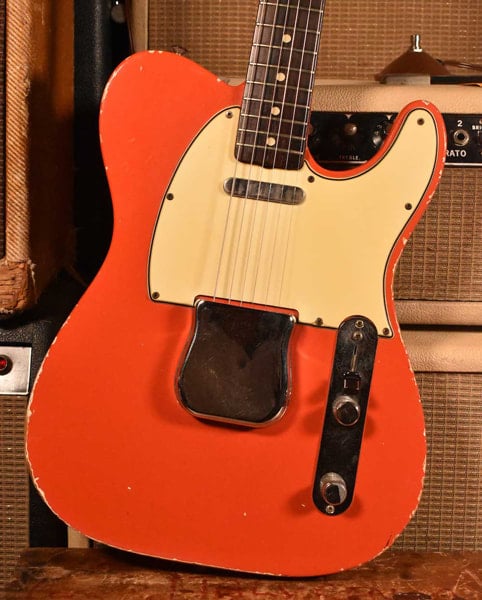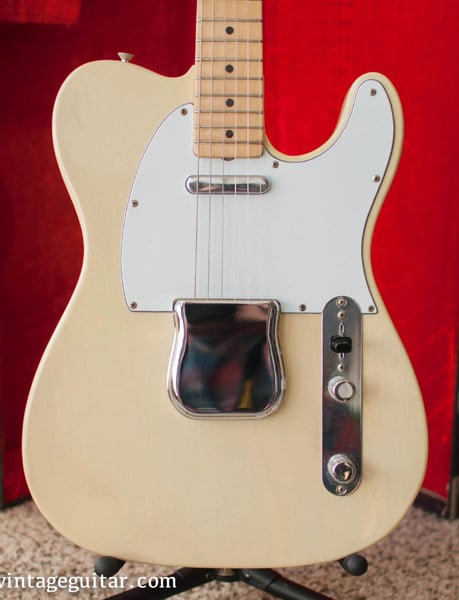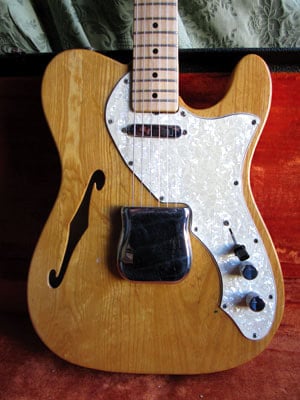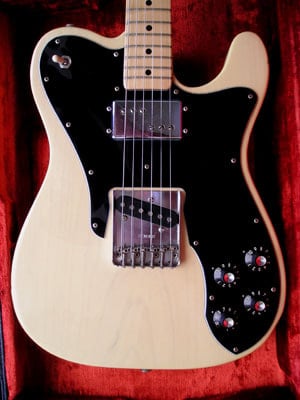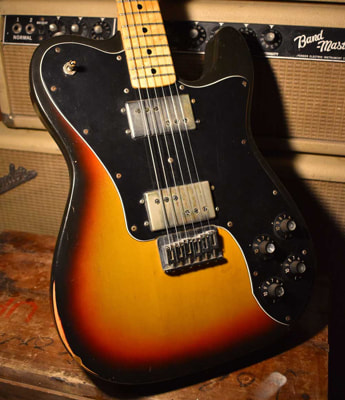The first two prototypes were fitted with slight different one-ply three-hole wing-shaped pickguards made of black phenolite, which both appeared to have been crudely cut without using a template.
Pre-production guitars sported larger four-hole phenolic pickguards, which featured a pointed edge on the cutaway area near the neck junction and appeared to be cut using a rough guide. They could be both black or white as the one used on the black pine-wood body Esquire shown on the April 1950 catalog.
Pre-production guitars sported larger four-hole phenolic pickguards, which featured a pointed edge on the cutaway area near the neck junction and appeared to be cut using a rough guide. They could be both black or white as the one used on the black pine-wood body Esquire shown on the April 1950 catalog.
|
The definitive one-ply five-hole pickguard was stamped with Race & Olmsted die and introduced during July 1950. Up until late 1954, Esquires, Broadcasters and Telecasters were fitted with these black pickguards with five countersunk holes and thus were often called black guards – although few five-hole white pickguards are known to exist.
The die cutting process lefts the edges of the early pickguards an uneven and rough look. After Spring 1951 they were buffed and beveled after being cut, hence it is common to find polishing compound around the edges, especially on the end facing of the bridge plate. Early black pickguards were lacquered for a glossier look. Since they were probably put on a paint can while being sprayed, they usually display a visible 5” ring on the underside. |
After May 1954 Fender started using one-ply white pickguards made of PVC on Telecaster and Esquire guitars, although Leo used some black phenolite sheets leftovers after Summer 1954 and Don Randall continued to show a black guard on 1950s advertising flyers because he believed it was more photogenic. PVC was easier to work with and less expensive.
|
The rough look and polishing compound around edges of the pickguard of an early Broadcaster. Photo from "The Pinecaster" by Nacho Banos and Lynn Wheelwright.
|
In mid-59, the new Telecaster Custom was fitted with a new three-ply white pickguard (W/B/W) made of celluloid, often called nitrate guard. Celluloid, which was imported from Italy, even when brand new showed a greyish/greenish (a.k.a. “mint green”) tint. With ageing, the front face became even more greyish or greenish.
The very first three-ply pickguards were still fastened by five screws, but by Summer 1959 all Telecasters pickguards were mounted on the body with eight screws, whether one-ply or three-ply. By the end of 1963, Fender switched to three-ply celluloid guards on the regular Telecasters, too.
After 1964, highly inflammable nitrate guards were discontinued on safety grounds and Fender replaced them with real white plastic units, although few nitrate guards were rarely used later.
The very first three-ply pickguards were still fastened by five screws, but by Summer 1959 all Telecasters pickguards were mounted on the body with eight screws, whether one-ply or three-ply. By the end of 1963, Fender switched to three-ply celluloid guards on the regular Telecasters, too.
After 1964, highly inflammable nitrate guards were discontinued on safety grounds and Fender replaced them with real white plastic units, although few nitrate guards were rarely used later.
Comparison between a '51 black pickguard and a '73 white pickguard. Courtesy of Cesco's Corner and True Vintage Guitar
By 1976, the regular Telecaster was fitted with a three-ply black pickguard, but, during 1981, a three-ply white guard was reinstated.
In mid-83, the new Standard Telecaster featured a one-ply white guard. At first, it was fastened by eight screws, but Fender switched soon to five screws.
3-Ply 8-hole white pickguards were later resurrected for the American Standard.
In mid-83, the new Standard Telecaster featured a one-ply white guard. At first, it was fastened by eight screws, but Fender switched soon to five screws.
3-Ply 8-hole white pickguards were later resurrected for the American Standard.
MOUNTING SCREWS
All the 1950 Telecaster-style guitars featured slot heads. In 1951, Fender started a gradual transition towards Phillips heads screws, but the transition was completed by the end of 1953, because Leo Fender didn’t want to waste anything.
The pickguard screws changed to Phillips heads in late 1952.
The pickguard screws changed to Phillips heads in late 1952.
OTHER MODELS
The new Telecaster Thinline, introduced in 1968, featured an elongated pickguard with a white shell top face, although some early Thinlines were equipped with a straight three-ply white guard.
At the end of 1971, the Thinline model was redesigned with two humbuckers and was equipped with a new pickguard with a different shape. Straight three-ply white pickguards became the norm, whilst pearloid units were gradually phased out.
Oddly enough, it is not unusual to find a pearloid face as the underside of some late ‘60s and early ‘70s white pickguards.
By 1976, the Telecaster Thinline was equipped with a three-ply black pickguard.
The Deluxe and the Custom Telecasters redesigned in the early ‘70s were equipped with elongated three-ply black pickguards, which covered a fair amount of the body.
Logically, the ’52 Vintage Reissue Telecaster was equipped with a one-ply black guard fastened to the body with 5 screws.
At the end of 1971, the Thinline model was redesigned with two humbuckers and was equipped with a new pickguard with a different shape. Straight three-ply white pickguards became the norm, whilst pearloid units were gradually phased out.
Oddly enough, it is not unusual to find a pearloid face as the underside of some late ‘60s and early ‘70s white pickguards.
By 1976, the Telecaster Thinline was equipped with a three-ply black pickguard.
The Deluxe and the Custom Telecasters redesigned in the early ‘70s were equipped with elongated three-ply black pickguards, which covered a fair amount of the body.
Logically, the ’52 Vintage Reissue Telecaster was equipped with a one-ply black guard fastened to the body with 5 screws.

